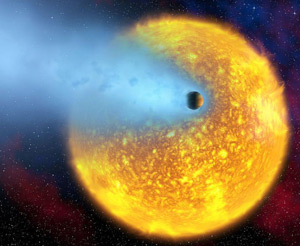There’s been a lot of exoplanet news lately! Part of that is due to the American Astronomical Society meeting recently – in fact, there was so much I wrote four articles just from that (Part 1, Part 2, and Part 3, and Part 4). This next story wasn’t released at the meeting, yet may honestly be the most mind-blowing of them all.
Astronomers have found what appears to be a planet literally boiling away from the blast-furnace heat of its star.
Holy cosmic oxyacetylene torch!
[Image: Reign of Fire by the extremely talented space artist Inga Nielsen. She has prints of them for sale, too!]
There’s a bit of a back story here. The star, KIC 12557548, is about 1500 light years away, and is one of many thousands being observed by the orbiting Kepler Observatory (KIC stands for Kepler Input Catalog, a list of stars under Kepler’s watchful eye). The observatory stares at one spot in the sky, looking for stars whose brightness dips periodically. There can be many causes of such behavior, one of which is the presence of planets orbiting the star and blocking the light from it as they pass in front of it. This is called a transit, and has proven to be wildly successful; hundreds of planets have been discovered this way.
What the authors of this new study are saying is that they see a periodic dip in the brightness of KIC 12557548 every 15.685 hours. Yes, hours. The star is a bit smaller and cooler than the Sun (a K star with about 0.7 times the mass of the Sun, if you want specifics), but even so, the planet must orbit the star a mere 1.5 million kilometers (900,000 miles) from its surface – that’s less than four times the distance of the Moon from the Earth!
That’s close. You’d expect the planet to be cooking… and you’d be right. It’s probably somewhere around 2000°C (3600°F).
Usually, with most planets, the amount of light blocked as the planet passes in front of the star is the same every time. That makes sense, because the planet itself isn’t changing. But not for KIC 12557548. What they saw was that every transit was different. Sometimes more than 1% of the light is blocked, sometimes they detect no dimming at all at the appointed time. That’s really weird.
They looked at and eliminated a few different scenarios, but the fact that the planet is that close to the star really leaves just one idea: a rocky world, probably half the diameter of Earth, being vaporized by the heat of its parent star*.
Yegads.
 It sounds crazy, but it fits a lot of their data. The planet has to be small, or else its gravity would be enough to hold onto the hot material. The outflowing material is thick and dusty, so it can block the light from the star. Changes in the amount of light blocked are due to changes in the dust cloud, which themselves may be due to inhomogeneities in the planet itself; different layers and features being vaporized. Sometimes there’s no dust at all, and the planet is too small to be detected blocking the star, so no dip in light is seen.
It sounds crazy, but it fits a lot of their data. The planet has to be small, or else its gravity would be enough to hold onto the hot material. The outflowing material is thick and dusty, so it can block the light from the star. Changes in the amount of light blocked are due to changes in the dust cloud, which themselves may be due to inhomogeneities in the planet itself; different layers and features being vaporized. Sometimes there’s no dust at all, and the planet is too small to be detected blocking the star, so no dip in light is seen.
Given all this, it’s possible to estimate how much mass is lost by the planet, and the answer is a staggering 100,000 tons per second. That sounds like a lot – and it is! – but planets are pretty big, even “super-Mercuries” like this one. It would take hundreds of millions of years to totally evaporate the planet at that rate, so it’ll most likely be around for a while for us to study.
How amazing would it be to be there (protected thoroughly, of course)? Imagine: from the planet, the star eats up half the sky, hundreds of times bigger than the Sun looks from Earth. Blazing down, fierce, uncompromising, the heat is intense and all-encompassing. The surface of the planet is glowing, liquid lava. There’s an atmosphere, but it’s composed of vaporized rock and it’s as hot as the devil’s breath. Flowing upward under the weak gravity, the dusty gas itself glows from heat as it rises up into space. The wind and pressure from the light of the star itself pushes on the gas, forming a long, graceful curve like the tail of a comet, stretching for millions of kilometers behind and away from the planet.
It’s a disaster on a planetary scale, an entire world boiling away in front of your eyes! And it will only end when the planet itself is gone, evaporated, vaporized.
Pfffffft!
The more I read about exoplanets, the more I wonder what surprises are in store for us. We’ve only just started looking for them! We need bigger telescope, better equipment, and simply more eyes on the sky. What other crazy amazing thing is out there just waiting for us to see it?
Tip o’ the Galactus helmet to Dan Vergano at USA Today. Image credits: Inga Nielsen, Gate to Nowhere; NASA, European Space Agency, Alfred Vidal-Madjar (Institut d’Astrophysique de Paris, CNRS).
* I’ll note that another planet, HD 209458b, is so hot that its atmosphere is puffed up and is being lost to space, like a gigantic comet. But that’s the atmosphere; for this planet we’re talking the actual surface being boiled away. Craziness.